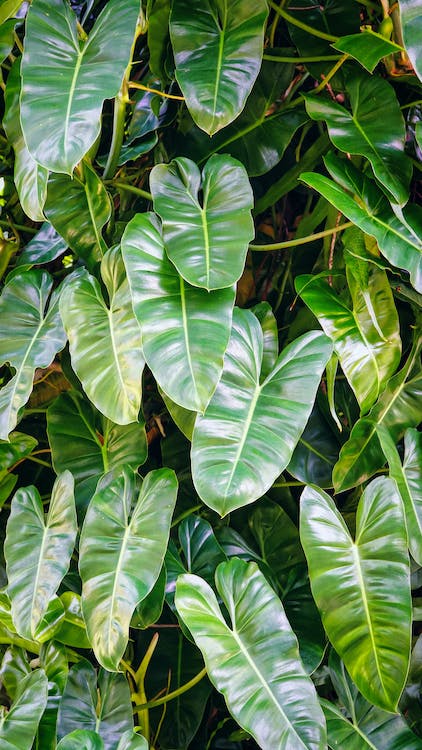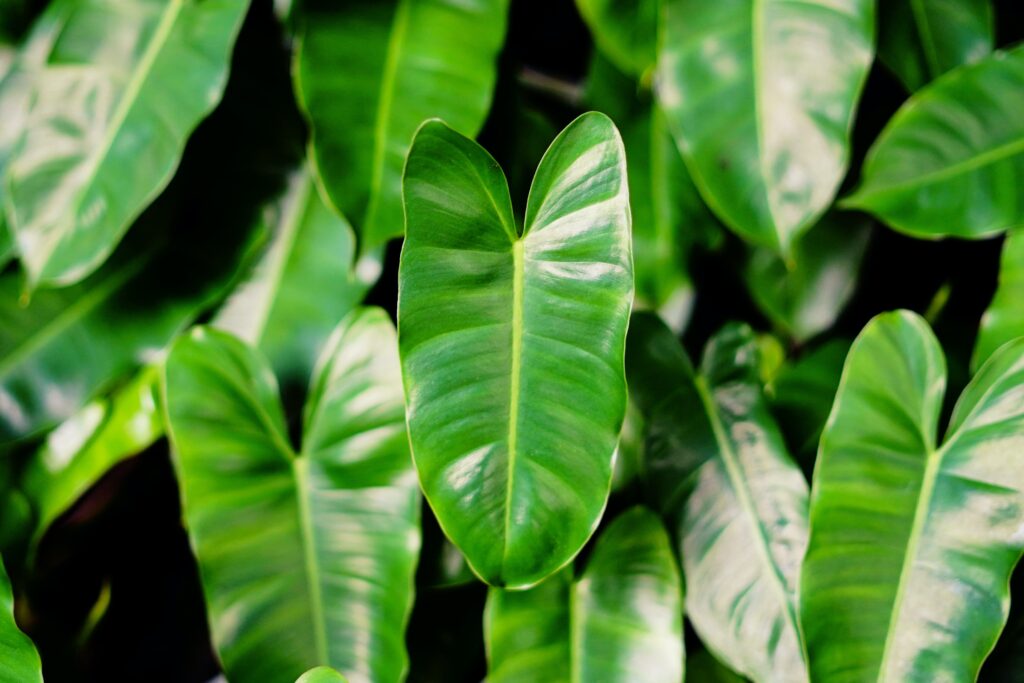Philodendron Bernardopazzi, commonly known as Bernardopazzi philodendron, is a stunning tropical houseplant that belongs to the Araceae family.
Because of its beautiful heart-shaped leaves and low-maintenance nature, it has become a popular choice for indoor gardening enthusiasts
Originating from the lush rainforests of Central and South America, this plant is revered for its attractive appearance and remarkable characteristics.
Its dark green leaves have prominent veins and can grow up to 6 inches in length, which looks attractive. Philodendron Bernardopazzi displays unique qualities that make it a sought-after item for collectors.
Its growth pattern is slow, which only adds to its attractiveness, and it remains relatively compact, making it suitable for small living spaces.
Understanding the Ideal Growing Conditions
To cultivate a healthy and vibrant Philodendron Bernardopazii, it is crucial to provide the ideal growing conditions that mimic its natural habitat.
Light Requirements
This exotic beauty thrives in bright, indirect light. Placing it near a north-facing window or providing filtered light from a sheer curtain will ensure optimal growth. Avoid direct sunlight, as it can scorch the leaves.
Temperature and Humidity
Maintaining a warm and humid environment is essential for the well-being of Philodendron Bernardopazi.
The ideal temperature range falls between 65°F to 80°F (18°C to 27°C). Regular misting or using a humidity tray will help create the required moisture levels.
Soil and Potting
A well-draining, nutrient-rich potting mix is vital for Philodendron Bernardopazii. A mix containing peat moss, perlite, and orchid bark offers excellent aeration and drainage.
Choose a pot with drainage holes to prevent waterlogged roots.
Proper Watering Techniques
Finding the right balance of watering is crucial for the health of your Philodendron Bernardopazii.
Watering Frequency
Allow the top inch of the soil to dry before watering again. Overwatering can lead to root rot, while underwatering can cause stress to the plant. Strike a balance by monitoring the soil moisture regularly.
Watering Method
When watering, use room-temperature water and avoid wetting the velvety foliage excessively. A watering can with a narrow spout will allow you to target the soil without drenching the leaves.
Fertilizing Philodendron Bernardopazii
Proper fertilization is essential to support the growth and overall health of your precious Philodendron Bernardopazii.
Choosing the Right Fertilizer
Opt for a balanced, liquid fertilizer specifically formulated for houseplants. Dilute the fertilizer to half or a quarter of the recommended strength to avoid over-fertilization.
Fertilizing Schedule
During the growing season (spring and summer), fertilize your Philodendron Bernardopazii every two to four weeks. Reduce or halt fertilization during the dormant period (fall and winter).
Pruning and Propagation
Pruning and propagation are essential aspects of Philodendron Bernardopazii care.
Pruning
Regularly prune away any yellowing or damaged leaves to maintain the plant’s health and appearance. You can also trim leggy stems to encourage bushier growth.
Propagation
Propagating Philodendron Bernardopazii can be done through stem cuttings. Take a 4-6 inch cutting with at least two nodes and place it in a moist potting mix. Provide warmth and indirect light, and roots should develop in a few weeks.

Types of Philodendron Bernardopazi
Some popular and widely known Philodendron varieties include:
- Philodendron hederaceum (Heartleaf Philodendron):
- Characteristics: Heart-shaped leaves, vining habit, and easy care make this one of the most common and beloved Philodendron species.
- Philodendron Bipinnatifidum (Split-Leaf Philodendron):
- Characteristics: Large, deeply lobed leaves that give the appearance of a split leaf. This plant is often chosen for its dramatic foliage.
- Philodendron Xanadu:
- Characteristics: Compact growth habit with deeply lobed leaves. It’s a popular choice for indoor landscaping and can thrive in bright, indirect light.
- Philodendron Selloum:
- Characteristics: Large, deeply lobed leaves with a tropical appearance. It’s commonly used in outdoor landscaping in suitable climates.
Common Pests and Problems
While Philodendron Bernardopazii is relatively hardy, it may encounter some common issues.
- Overwatering: Like many houseplants, overwatering can lead to root rot and other fungal issues. It’s crucial to allow the top inch of soil to dry out before watering again and ensure that the pot has proper drainage.
- Underwatering: On the other hand, underwatering can cause the leaves to wilt and eventually turn brown. Consistently keeping the soil too dry can stress the plant.
- Improper Light: Philodendron Bernardopazii prefers bright, indirect light. If placed in low light conditions, it may suffer from stunted growth, leggy stems, and reduced leaf vibrancy.
- Pests: While philodendrons are generally quite resilient against pests, they can occasionally attract common houseplant pests like spider mites, mealybugs, and aphids. Regularly inspect the plant for any signs of infestation and take appropriate measures to address the issue.
- Leaf Damage: Large, delicate leaves are susceptible to damage. Be cautious of accidental physical damage or tearing when moving or handling the plant.
- Cold Sensitivity: Philodendron Bernardopazii is sensitive to cold temperatures. Exposure to temperatures below 55°F (13°C) can harm the plant, leading to leaf damage or death.
- Nutrient Deficiencies: Lack of essential nutrients, particularly nitrogen, phosphorus, or potassium, can manifest as yellowing leaves or poor growth. Regularly fertilize the plant during the growing season with a balanced liquid fertilizer.
- Incorrect Pot Size: Using a pot that is too large can lead to waterlogged soil and hinder root health. Choose a pot that provides a little room for growth but is not excessively oversized.
- Lack of Support: Since Philodendron Bernardopazii is a climbing plant, it requires some support as it grows. A trellis, moss pole, or other support structure can help the plant climb and thrive.
- Toxicity: As with many philodendron species, Philodendron Bernardopazii contains calcium oxalate crystals that can cause skin irritation or more severe reactions if ingested. Handle the plant with care and keep it out of reach of pets and children.
| Appearance: Leaves: The most distinctive feature of Philodendron Bernardopazii is its large, heart-shaped leaves. The leaves are deeply lobed and have a velvety texture, which gives them a lush and luxurious appearance. The color of the leaves is a vibrant green with prominent veins running through them. Leaf Size: The leaves of this philodendron can grow to impressive sizes, often reaching up to 2 feet (60 cm) or more in length. The leaves emerge from long, sturdy stems that arise from the plant’s central crown. Growth Habit: Philodendron Bernardopazii has a climbing growth habit, and as it matures, it may produce aerial roots along its stems, which help it cling and climb on nearby support structures. Flowers: Like many philodendron species, Philodendron Bernardopazii can produce flowers, but they are not the primary attraction of this plant. The flowers are typically small, inconspicuous, and often hidden within the foliage. Toxicity: It’s essential to note that Philodendron Bernardopazii, like many other philodendron varieties, contains calcium oxalate crystals, which can be toxic if ingested. Keep it away from curious pets and small children. |
Philodendron Bernardopazii Narrow
There is no specific plant known as “Philodendron Bernardopazzi narrows”. New varieties or variations may have appeared since then, but it is essential to verify the accuracy and authenticity of such claims before purchasing.
Standard Philodendron Bernardopazzi is characterized by large, heart-shaped leaves with deep lobes and a velvety texture.
If you’re looking for specific cultivars, consider checking with specialty plant nurseries or joining plant enthusiast communities for the latest information.
Philodendron Bernardopazii for Sale
There are several places where you can find them for sale:
- Local Plant Nurseries: Visit nearby plant nurseries or garden centers, as they may have a selection of Philodendron Bernardopazii or be able to source one for you.
- Online Plant Retailers: Many online plant retailers offer a wide variety of houseplants, including rare species like Philodendron Bernardopazii. Search for reputable online plant shops that can deliver the plant to your location.
- Plant Enthusiast Forums and Groups: Join online plant communities on social media platforms or forums where plant enthusiasts exchange information and sometimes offer plants for sale or trade.
- Plant Shows and Sales Events: Check for local plant shows, fairs, or sales events in your area, where you might find rare plants like Philodendron Bernardopazii from vendors or collectors.
- Specialty Plant Shops: Some specialty plant shops focus on rare and exotic plants, and they might have Philodendron Bernardopazii available or can help you source one.
When purchasing plants online, ensure you are buying from a reputable seller to ensure the quality of the plant and safe delivery. Additionally, check the seller’s policies on shipping and plant health guarantees.
Keep in mind that Philodendron Bernardopazii is a rare and sought-after plant, which may influence its availability and pricing.
Be prepared for the possibility that it might not be readily available at all times or could be more expensive than more common houseplants.
Conclusion
Philodendron Bernardopazi is a delightful addition to any indoor garden, bringing a touch of tropical rainforest into your home. You can create an environment where your plant will flourish and thrive.
Remember to maintain a balance in watering, light exposure, and humidity to keep your Philodendron Bernardopazi happy and healthy.
| Frequently Asked Questions (FAQs) Q: How often should I water my Philodendron Bernardopazi? A: Water your plant when the top inch of soil is dry to the touch. The frequency may vary depending on your home’s humidity and temperature. Q: Can I keep my Philodendron Bernardopazi in a windowless room? A: While it prefers bright, indirect light, it can tolerate lower light conditions. However, a windowless room might not provide enough light for optimal growth. Q: Should I mist my Philodendron Bernardopazi every day? A: Misting can help increase humidity, but daily misting may lead to fungal issues. Opt for misting a few times a week instead. Q: How often should I fertilize my plant? A: During the growing season, fertilize every two to four weeks. In winter, reduce the frequency to once a month. Q: Can I use tap water for my Philodendron Bernardopazi? A: Tap water is generally fine, but letting it sit for 24 hours before use allows the chlorine to dissipate, which is beneficial for the plant. |

